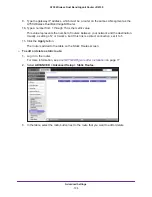
Advanced Settings
120
A750 Wireless Dual Band Gigabit Router JR6150
Port Triggering to Open Incoming Ports
In the preceding example, your router sends requests to a remote computer from a particular
service port number, and replies from the remote computer to your router are directed to that
port number. If the remote server sends a reply to a different port number, your router does
not recognize it and discards it. However, some application servers (such as FTP and IRC
servers) send replies to multiple port numbers. Using the port triggering function of your
router, you can tell the router to open more incoming ports when a particular outgoing port
originates a session.
An example is Internet Relay Chat (IRC). Your computer connects to an IRC server at
destination port 6667. The IRC server not only responds to your originating source port, but
also sends an “identify” message to your computer on port 113. Using port triggering, you can
tell the router, “When you initiate a session with destination port 6667, you must also allow
incoming traffic on port 113 to reach the originating computer.”
Using steps similar to the preceding example, the following sequence shows the effects of
the port triggering rule you have defined:
1.
You open an IRC client program to start a chat session on your computer.
2.
Your IRC client composes a request message to an IRC server using a destination port
number of 6667, the standard port number for an IRC server process. Your computer then
sends this request message to your router.
3.
Your router creates an entry in its internal session table describing this communication
session between your computer and the IRC server. Your router stores the original
information, performs Network Address Translation (NAT) on the source address and port,
and sends this request message through the Internet to the IRC server.
4.
Noting your port triggering rule and having observed the destination port number of 6667,
your router creates an additional session entry to send any incoming port 113 traffic to your
computer.
5.
The IRC server sends a return message to your router using the NAT-assigned source port
(as in the previous example, say port 33333) as the destination port. The IRC server also
sends an “identify” message to your router with destination port 113.
6.
When your router receives the incoming message to destination port 33333, it checks its
session table for an active session for port number 33333. Finding an active session, the
router restores the original address information replaced by NAT and sends this reply
message to your computer.
7.
When your router receives the incoming message to destination port 113, it checks its
session table and finds an active session for port 113 associated with your computer. The
router replaces the message’s destination IP address with your computer’s IP address and
forwards the message to your computer.
8.
When you finish your chat session, your router eventually senses a period of inactivity in the
communications. The router then removes the session information from its session table,
and incoming traffic is no longer accepted on port numbers 33333 or 113.
To configure port triggering, you must know which inbound ports the application needs. Also,
you must know the number of the outbound port that triggers the opening of the inbound
ports. You can usually find this information by contacting the publisher of the application or
user groups or newsgroups.
















































